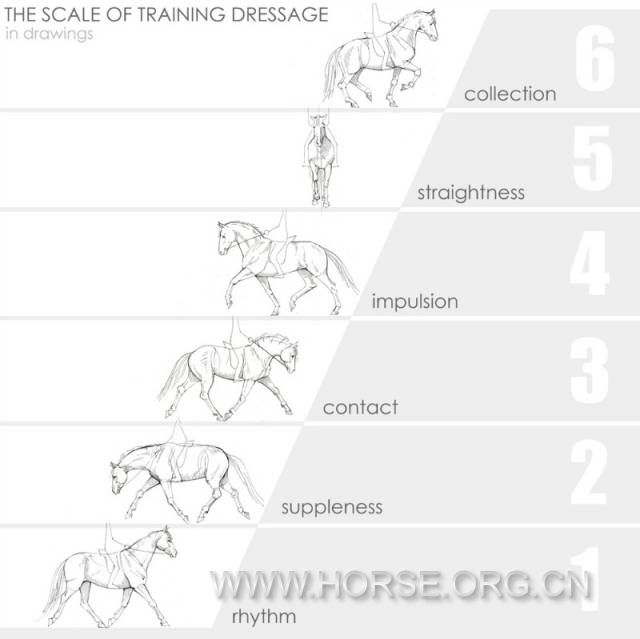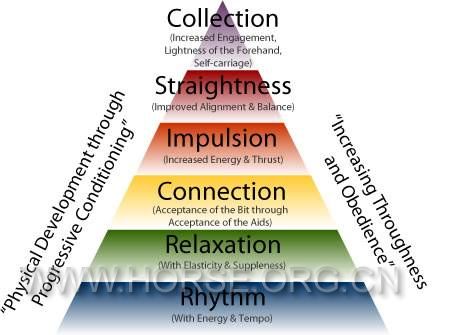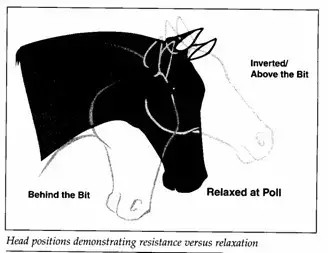马上注册,结交更多马友,享用更多功能
您需要 登录 才可以下载或查看,没有账号?立即注册
x

1.Rhythm 韵律
2.Suppleness 柔软
3.Contact 联系
4.Impulsion 前进气势
5.Straightness 正直
6.Collection 收缩
世界上最好的骑手和调教师会告诉你好的训练是一层一层建立起来的,牢固又坚实。在特定顺序下这个基础由以上6要素组成。
所有这些要素合起来被称做训练准则,也被称为训练金字塔,德国训练准则,或者德国训练系统。如果你把它看做一个韵律在最下,一层层堆起的金字塔或许可以帮助你理解训练准则是如何在你的马匹调教中发挥作用的。

训练准则的这六步,没有一个是可以独立进行的。它们互相结合使用。训练的总体目标是调教出一匹通透的马,一匹在所有动作和转换时没有丝毫抵抗,愿意立即服从骑手辅助的马。准则适用所有的马与所有的马术运动项目,不是只针对马场马术而已。
联系-接受衔铁和扶助
联系是骑手的手与马嘴之间轻柔稳定的连结。在骑手的驱动辅助下,马有韵律的前进并“寻找”与骑手的手的联系,从而 “进入” 接触。 “马寻找联系,骑手提供联系”。
正确稳定的接触,可让马在所有的步伐中找到好的平衡和节奏。除了在长韁时要马向前/向下之外,项部应始终在颈部的最高点。

联系必须是将马后肢活跃的能量,通过到摇动的背部,再到口衔的结果。用手往后拉来试图得到联系是完全错误的。这样做一定会使后驱的动力不能向前传递。马应该对骑手的驱动扶助做出反应,有信心的往前进入联系。
好的联系的指标有:
马透过正直且柔软的项部,往前趋向口衔。
马嘴安静轻柔的咀嚼口衔,接受弹性的接触。
马的舌头不应该伸出来(被看到)。
项部在最高点。

马鼻子在垂线之前,在做高度收缩的动作时鼻子在垂线上。
在中度和伸长步伐时,应明显的看到马体拉长。
裁判应该分辨以下几点:
马鼻子在垂线之后:这是由于手用得太多(太用力,太硬)。这个错误可能由于使用辅助时的一时错误,也可能是长期错误训练的症状。
避衔,失去联系:马拒绝接受口衔。经常与此一起出现的是颈部的脊椎弯曲高出项部。
颈部的拱形破裂。会出现这种情况,是因为骑手在试图建立联系时是靠手往后拉的结果。项部已不再是颈部的最高点,颈部的最高点往后移,通常在第二节和第三节脊椎骨之间。

靠在口衔上:由于马的后驱工作不足,它寻求骑手的手来支撑,这样做就像是有了第五条腿。
抗衔:马鼻子在垂线前面许多。马的项部不会弯曲,用颈部下方的肌肉抵抗骑手的手,同时背部僵硬凹陷。

判断马是否正确的接受联系,或者说“受衔” 时,只看头部与颈部是不够的。应该看整匹马的整体,它的姿态和承载,尤其是它移动方式。
Contact is the soft, steady connection between the rider’s hand and the horse’s mouth. The horse should go rhythmically forward from the rider’s driving aids and “seek” contact with the rider’s hand, thus “going into” the contact. “The horse seeks the contact and the rider provides the contact”.
A correct, steady contact allows the horse to find its balance under the rider and a good rhythm in all the paces. The poll should always be the highest point of the neck, except when the horse is being ridden forward/downward with longer reins.
The contact must result from the energy of active hind legs being transferred over a swinging back to the bit. It is totally wrong to try to obtain the contact by pulling back with the hands. This way of riding will always stop the energy coming through from behind. The horse should go forward confidently into the contact in response to the rider’s driving aids.
Indications of good contact are:
The horse step forward to the bit through a straight and supple poll.
The horse accepts an elastic contact with a quiet mouth gently chewing the bit. The tongue is not visible.
The poll is the highest point.
The line of the nose is in front of the vertical, and in highly collected exercises at the vertical.
In medium and extended paces there should be a visible lengthening of the frame.
Judges should always differentiate between:
Nose behind the vertical: This is caused by hands used too strongly. This fault may result either from a momentary mistake in applying the aids or it may be a symptom of long-term incorrect schooling.
Behind the bit, dropping the contact: The horse refuses to accept the bit. Often associated with this is a flexion at the vertebrae further down the neck rather than at the poll.
Broken arch in the neck. This occurs as a result of the rider attempting to establish the contact by using hands in a backward direction. The highest point of the neck is no longer the poll but a point further back, usually between the second and third vertebrae.
Leaning on the bit: Because the horse is not working sufficiently from behind, it seeks support from the rider’s hands, using them as a “fifth leg”.
Against the hand, above the bit: The horse’s nose is well in front of the vertical. The horse will not flex at the poll and uses the muscles in the underside of the neck to resist the hand, while at the same time stiffening and hollowing its back.
When judging whether a horse is correctly accepting the contact or “on the bit”, it is not enough to look only at the head and neck. Judges need to look at the whole horse, its position and carriage and, in particular, the way it moves.
来源:申申马术
|
|